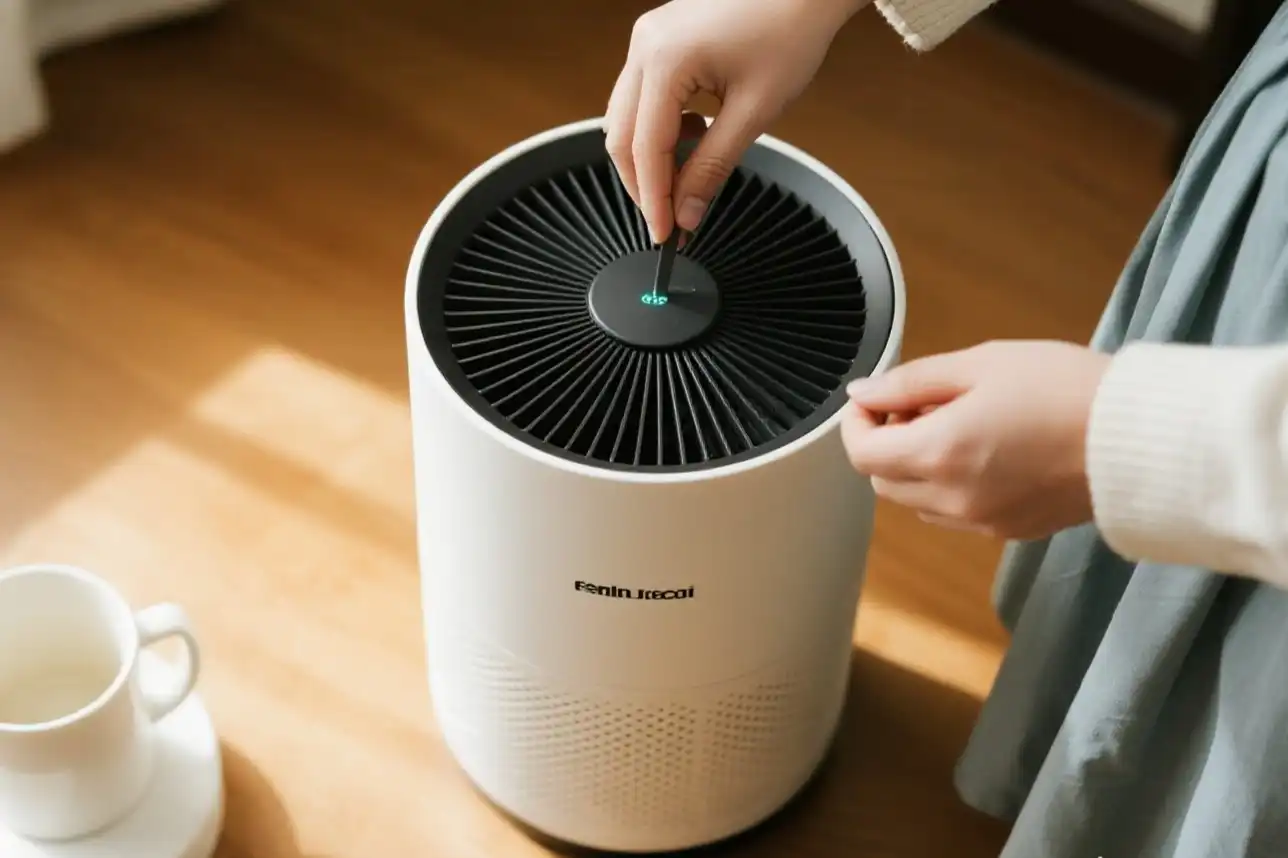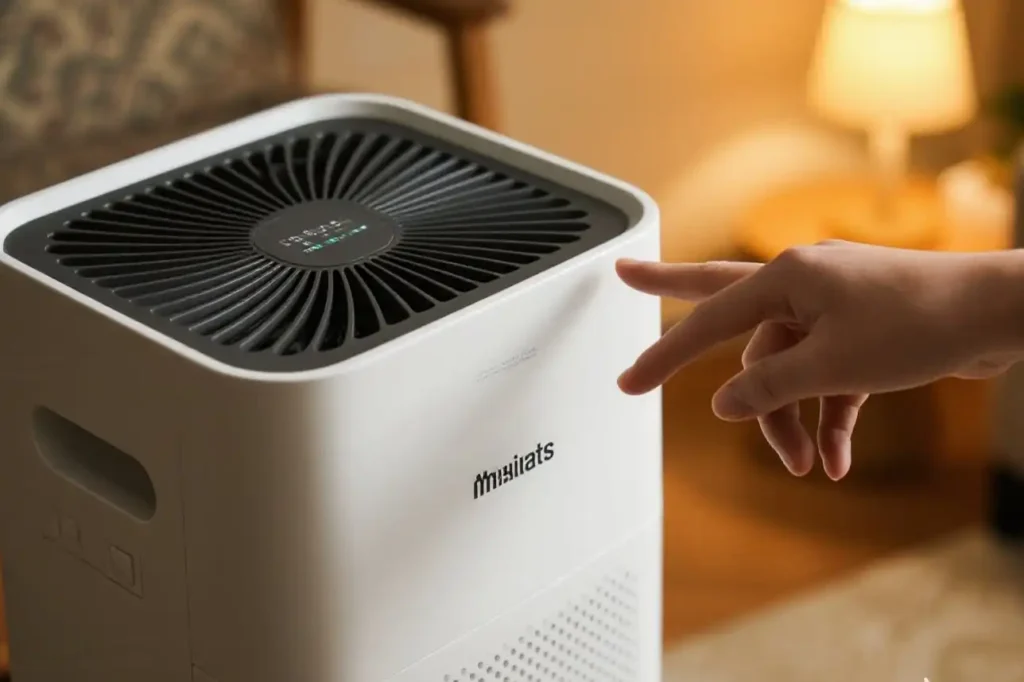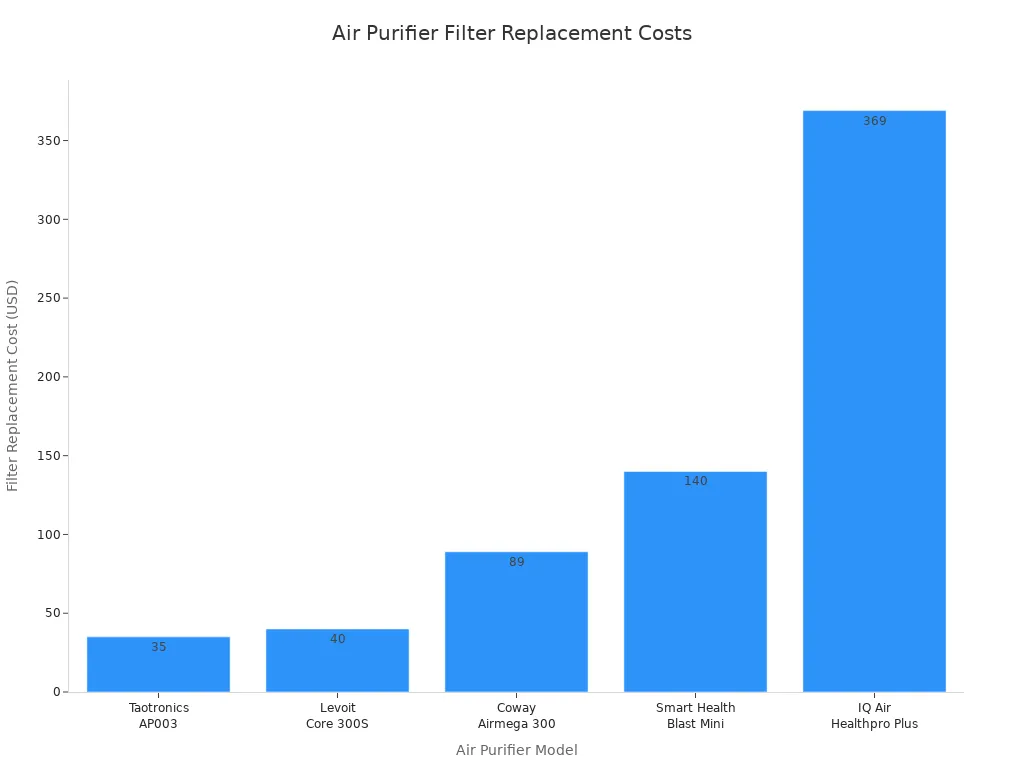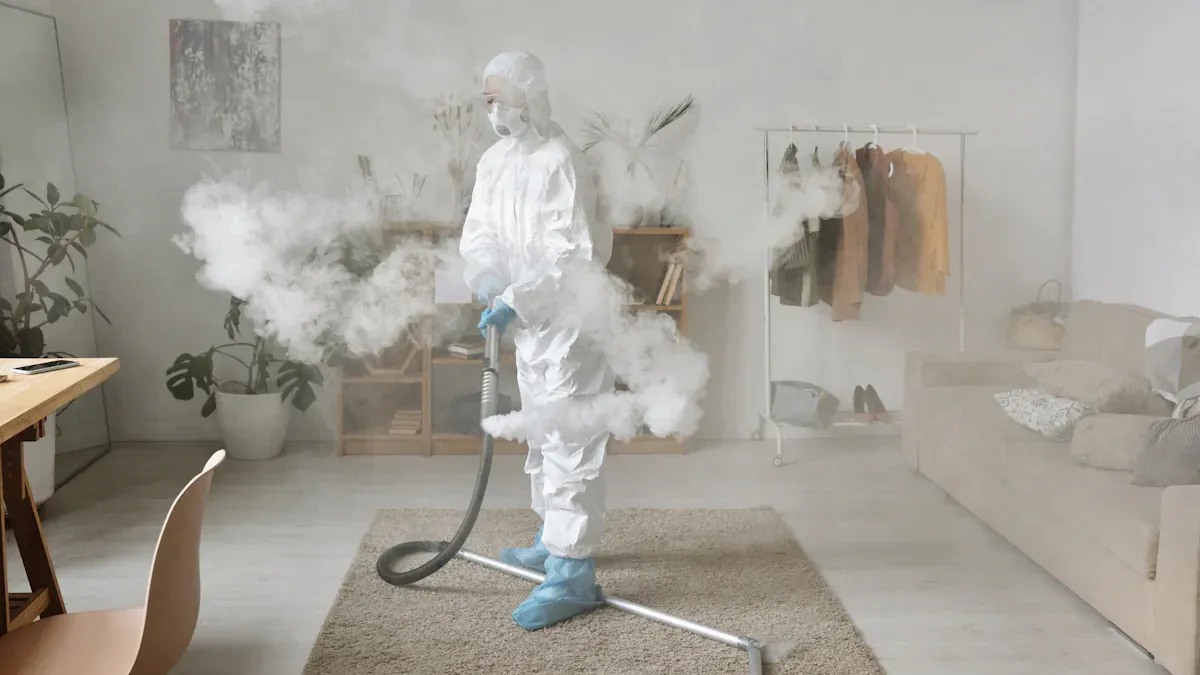
You might ask if you really need an air purifier at home. Maybe your eyes feel itchy, your throat feels scratchy, or you get headaches after being inside. These things can mean the air in your home is not clean.
Some common signs of indoor air pollution are:
- Eyes, nose, or throat feel sore or itchy
- Headaches or feeling very tired
- Coughing, wheezing, or chest pain
- Skin feels dry or gets irritated
If you have pets, allergies, or live in a busy city, you may notice these problems more. An air purifier can help lower these problems and make your home feel cleaner.
Key Takeaways
- Air purifiers take out dust, pollen, pet dander, smoke, and chemicals. This helps make the air inside cleaner. It can also help people with allergies or asthma feel better.
- People with asthma or allergies should think about getting an air purifier. People with pets or who live near busy roads should also think about it. If your home was just fixed up, you may need one too. It can help you feel healthier and more comfortable.
- Pick an air purifier with a HEPA filter for tiny particles. Get one with an activated carbon filter for smells and gases. Make sure the Clean Air Delivery Rate (CADR) fits your room size.
- Put your air purifier in the middle of the room. Do not put it near walls or in corners. Keep it about three feet above the floor. This helps it work best.
- Change the filters often. Do not use machines that make ozone. Use your air purifier with good cleaning and open windows for the cleanest air at home.
Do You Need an Air Purifier?
Who Should Consider One
You might not know if you need an air purifier at home. Some people need one more than others. If you have asthma or allergies, dirty air can be worse for you. People with breathing problems are at higher risk. Kids, older adults, and pregnant people can also get sick from bad air. Even if you feel fine, you can still breathe in dust and pollen. Chemicals in the air can also cause problems later.
People with pets or who live near busy roads may notice more dust and smells. Living in a city with lots of pollution can make this worse. If you just painted or remodeled, your air may have more chemicals called VOCs. These can make your eyes itch or your nose run. Doctors say air purifiers help most in homes with little fresh air. Apartments or houses with closed windows need them more.
Here are some groups who should think about getting an air purifier:
- People with asthma, allergies, or COPD
- Children and babies
- Older adults
- Pregnant people
- Anyone living with pets
- People near highways, factories, or construction
- Families with recent home renovations
- Anyone wanting to lower the risk of airborne viruses
Tip: During wildfire season or when outside air is bad, everyone can use cleaner indoor air.
Air purifiers help these groups by taking out tiny particles and allergens. Studies show that using a HEPA filter lowers indoor air pollution. This can help with coughing, sneezing, and even high blood pressure. Some studies found that air purifiers with HEPA and activated carbon filters can lower health risks from indoor air pollution by up to 86%.
Common Signs You Need One
You may not see bad air, but your body can tell you. Watch for these signs at home:
- You sneeze, cough, or get itchy eyes more inside than outside.
- You see dust on furniture soon after cleaning.
- Your home smells musty or has strong pet, cooking, or chemical odors.
- The air feels stuffy, especially if you keep windows closed.
- You or your family have trouble sleeping because of dry throats, coughing, or sinus problems.
- You see more pet hair and dander floating around.
- You live near busy roads, factories, or construction and notice more dirt or smells inside.
- You have done home repairs or painting and notice new smells or headaches.
- You want to protect your family from things like mold spores, bacteria, or viruses.
Let’s see what science says about how well air purifiers work:
| Evidence Aspect | Details |
|---|---|
| Filtration Efficiency | HEPA filters remove 99.97% of particles that are 0.3μm or bigger. |
| Pollutants Reduced | Air purifiers lower dust, pollen, smoke, VOCs, mold spores, allergens, and some viruses. |
| Health Benefits Observed | People say they cough less, breathe better, and have lower blood pressure. |
| Key Performance Metric | Clean Air Delivery Rate (CADR) shows how fast a purifier cleans the air. A higher CADR means better results. |
| Policy and Consumer Implications | Experts say HEPA air purifiers are a good way to make indoor air better. |
If you notice any of these signs, an air purifier can help you breathe easier and feel better at home. Opening windows and cleaning help, but air purifiers catch tiny particles and smells that other ways miss. They work fast and can really help, especially for people who are sensitive to dust, pollen, or chemicals.
Air Purifier Benefits
Cleaner Air at Home
You want your home to feel fresh and safe. An air purifier helps you reach that goal by removing many things you cannot see. Studies show that HEPA filters can take out almost all tiny particles, like dust and pollen, from the air. In fact, HEPA filters remove at least 99.97% of particles as small as 0.3 microns. That means less dust on your shelves and fewer sneezes.
Here’s what air purifiers can remove from your home:
- Fine particles (PM2.5) from smoke, dust, and pollution
- Pollen and mold spores
- Pet dander and hair
- Some bacteria and viruses
- Gases like formaldehyde and VOCs (from paint or cleaning products)
Tip: Some air purifiers also help with odors from cooking or pets, making your home smell cleaner.
The amount of pollution removed depends on the type of filter, how often you run the machine, and how big your room is. Most people see a big drop in dust and fine particles after just a few days of use.
Health and Comfort
Breathing cleaner air can make you feel better every day. If you have allergies or asthma, you may notice fewer symptoms. Research shows that using an air purifier can lower the amount of dust, pollen, and smoke in your home. Children with asthma often need less medicine when they use one. Some people even see lower blood pressure after using a purifier for a while.
You might also sleep better. In one study, people with allergies fell asleep faster and woke up less during the night when they used an air purifier in their bedroom. Over 80% of people said their sleep improved, and many noticed less dust and fewer odors.
A good night’s sleep starts with clean air. Air purifiers help you breathe easier, so you wake up feeling rested.
Cleaner air means fewer headaches, less coughing, and a more comfortable home for everyone.
Choosing an Air Purifier

Filter Types
When you shop for an air purifier, you will see different filters. Each filter helps with different problems in your house. Here is what you should know:
- HEPA filters catch very small things like dust, pollen, pet dander, mold spores, and some germs. They trap almost all particles as tiny as 0.3 microns. If you have allergies or pets, this filter is very helpful. HEPA filters do not get rid of smells or gases.
- Activated carbon filters soak up smells, smoke, and chemical fumes. They are good for kitchens, homes with smokers, or places that smell strong. These filters do not trap dust or allergens.
- Ionizers make particles stick to things by giving them a charge. They can help with smoke but do not remove smells. Some ionizers make ozone, which can be bad for you.
Many air purifiers use both HEPA and activated carbon filters. This gives you cleaner air and less odor.
Here is a simple chart to show how each filter works:
| Filter Type | Allergens (Dust, Pollen, Dander) | Smoke Particles | Chemical Odors & Gases |
|---|---|---|---|
| HEPA Filter | ✅ Works very well | ❌ Does not work | ❌ Does not work |
| Activated Carbon Filter | ❌ Does not work | ✅ Soaks up | ✅ Soaks up |
| Ionizer | ⚠️ Works a little | ⚠️ Helps some | ❌ Does not work |
Tip: Most people should pick a HEPA filter with activated carbon.
Room Size and Placement
You want your air purifier to clean the air well. It needs to match your room size. First, measure your room’s square feet. Check the Clean Air Delivery Rate (CADR) on the box. The CADR should be about two-thirds of your room size. For example, if your room is 150 square feet, pick a purifier with a CADR of at least 100.
If your ceiling is higher than 8 feet, get a purifier with a bigger CADR. In big rooms or open spaces, you may need more than one purifier. Put your purifier where you spend the most time, like your bedroom or living room.
Where you put your purifier is important. Do not put it in corners or right next to walls. Place it near things that make the air dirty, like windows, doors, or pet spots. Lift it about three feet off the floor for better results. Make sure nothing blocks the air from moving.
Putting your purifier in the right place can make it work up to 25% better.
Cost and Maintenance
Buying an air purifier is just the first step. You also need to think about changing filters and using power. Prices start at about $99 for simple models and go over $1000 for fancy ones. The cost to change filters depends on the model and type.
Here is a table to help you compare:
| Air Purifier Model | Filter Replacement Cost | Replacement Frequency |
|---|---|---|
| Taotronics AP003 | ~$35 | Every 3 to 6 months |
| Levoit Core 300S | ~$40 | Every 6 to 8 months |
| Coway Airmega 300 | ~$89 | Every 9 months |
| Smart Health Blast Mini | ~$140 | Every 18 to 24 months |
| IQ Air Healthpro Plus | ~$369 | Every 5 years |

- Most filters last 6 to 12 months.
- Some high-efficiency filters last up to 24 months.
- Carbon filters need changing more, about 2 to 4 times a year.
- Buying more filters at once can save you money.
Most air purifiers use 20 to 50 watts of power. Running one all day costs about $3 to $4 each month. Look for Energy Star models to save electricity.
Note: Some purifiers have smart features that tell you when to change the filter.
Safety Tips
Safety is important when picking an air purifier. Some types, like ozone generators and ionizers, can make ozone. Ozone can hurt your lungs, especially if you have asthma or allergies. Kids, older people, and pets are more at risk.
Here is what to look out for:
| Air Purifier Type | Safety Concerns | Health Risks | Recommendations |
|---|---|---|---|
| Ozone Generators | Make ozone gas | Can hurt lungs, cause asthma | Do not use at home |
| UV Light Purifiers | Might make ozone | Not much germ-killing, ozone risk | Not needed for most homes |
| Ionizers | Can make ozone, other bad stuff | Can cause breathing or brain issues | Use with care or avoid |
| HEPA/Activated Carbon Filters | No ozone or bad byproducts | Safe for all ages and pets | Best choice for most families |
Always check for safety labels before you buy. Look for these:
- AHAM seal (tested for safety and works well)
- UL 2998 (makes very little ozone)
- CARB certification (meets California’s tough rules)
- Energy Star (saves energy)
Keep your purifier clean and change filters on time. Put it where pets and small kids cannot knock it over. If you have birds, be extra careful—ozone and fumes can hurt them fast.
Tip: Stay away from any device that says “activated oxygen” or “super oxygen.” These are just other names for ozone.
Air Purifier Limitations

What They Can’t Do
You might think an air purifier solves every air problem at home, but that’s not true. These machines only clean the air while particles float around. Once dust, pollen, or pet hair settles on your couch or shelves, the purifier can’t touch it. You still need to dust and vacuum to keep your space truly clean. Over time, running a purifier can help reduce how much dust lands on surfaces, but it won’t remove what’s already there.
Some models also have a big downside: they can make ozone. Ozone sounds fresh, but it’s actually a harmful gas. Breathing in ozone can irritate your eyes, nose, and throat. It can make asthma worse and even cause long-term lung problems. Ozone generators, in particular, can fill your home with unsafe levels of this gas. Even some ionizers release small amounts, though usually less. That’s why experts and health agencies warn against using ozone-producing devices at home.
Note: Always check for safety labels like CARB certification or UL 2998 to make sure your device doesn’t add ozone to your air.
Air purifiers also have limits when it comes to germs and chemicals. HEPA filters can trap most bacteria and viruses, but not all. Some portable units only work well in one room. They can lower things like smoke, pollen, and some chemicals, but they can’t catch everything—especially if you have a big house or lots of rooms.
Other Ways to Improve Air
You can do more than just run a purifier to keep your air healthy. Try these steps:
- Change your HVAC or furnace filters often. Use filters rated MERV 13 or higher for better results.
- Cut down on burning things indoors, like candles, incense, or wood fires.
- Seal up cracks and gaps around windows and doors to keep dust and pollen out.
- Use exhaust fans in your kitchen and bathroom to get rid of moisture and cooking fumes.
- Test for radon and fix any problems if levels are high.
- Pick paints and cleaners with low VOCs to avoid harsh chemicals.
- Open your windows sometimes to let in fresh air, unless outdoor air is very polluted.
- Vacuum carpets and wash bedding often to remove dust and allergens.
- Keep humidity between 30% and 50% to stop mold from growing.
Ventilation and humidity control work together with air cleaning to give you the best results. Regular cleaning, fresh air, and the right humidity can make your home feel fresher and safer for everyone.
You want the cleanest air for your family, especially if you have allergies or pets. Studies show HEPA filters can cut dog allergens by 89% and cat allergens by 77%.
Before you buy, think about your room size, filter type, and how much maintenance fits your lifestyle. Make a quick checklist or talk to an expert if you feel unsure. Remember, clean air also comes from good habits like regular cleaning and letting in fresh air.
FAQ
What does an air purifier actually do?
An air purifier pulls air through filters. It traps dust, pollen, and other tiny things you cannot see. You get cleaner air to breathe at home.
What size air purifier do you need?
You need to match the air purifier to your room size. Check the box for the square feet it covers. Pick one that fits your biggest room for the best results.
What should you look for in an air purifier?
Look for a HEPA filter and a good Clean Air Delivery Rate (CADR). Make sure it does not make ozone. Check how often you need to change the filter.
What is the best place to put your air purifier?
Place your air purifier in the room where you spend the most time. Keep it away from walls and corners. Make sure nothing blocks the airflow.
What maintenance does an air purifier need?
You need to change the filters on time. Wipe the outside with a damp cloth. Check the manual for how often to clean or replace parts.
See also
Air Purifier Myths, Real Results, and How to Avoid Being Scammed
What to Expect When Using an Air Purifier at Home
